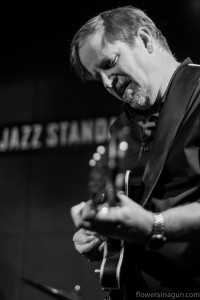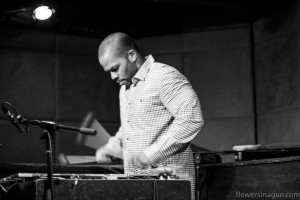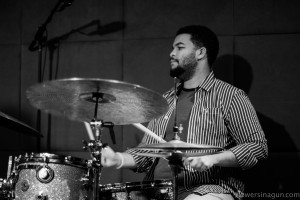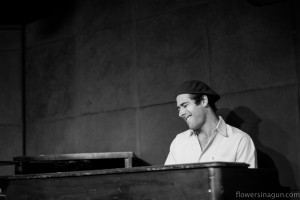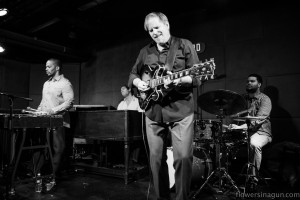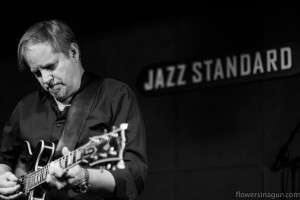Dave Stryker has been on New York jazz scene the 1980s and he played with Stanley Turrentine and Jack McDuff. Dave recorded over 20 CDs as a band leader and he also teaches jazz around the country. He was voted one of the top guitarist by the Down Beat in 2013. His latest CD “Eight Track” is a slightly different project that you would normally expect from a jazz musician. It ventures back in the 1970s and reworks the pop hits of the time ranging from Pink Floyd to Jackson 5. Recorded in December 2013 in New Jersey, the album features Jared Gold on Hammond B3 Organ, McClenty Hunter on drums, and Stefon Harris on vibraphone.
The CD Release for “Eight Track” at the Jazz Standard on August 6, 2014 featured a slightly different cast of musicians. Jared Gold ruled the organ, Kush Abadey the drums and Warren Wolf appeared as a special guest on vibraphone. The club was packed with fans who came up to Dave before the show and there was a nice overall vibe.
The hard driving guitar solos, the intensity of the organ offset by the dreamy vibes, the steady pulse of the rhythm section. It was a fun night of music. And then the lingering sense of having heard the songs before yet they became less familiar as band took them to a different place. Perhaps it’s a bit nostalgic, but ultimately the set made people connect with the music in a different way. And hopefully made the audience smile at their own memories from the time long gone.
Dave graciously agreed to talk to Flowers In A Gun about his musical career, influences and the story behind his newest project. Read the full interview and check out the new album.
Flowers In A Gun: You started playing guitar when you were 10 but it wasn’t until later that got into jazz. How did it happen?
Dave Stryker: I got into rock, the Beatles, so that was the first thing. I was from a town called Omaha in Nebraska, in the middle of the country. So when I started playing, I played with some guys who were older and then got a little rock band together. We started playing gigs, got pretty good. And then I went to the jam sessions at the Union, it was a jazz jam session. I just got up there and started playing my Rock’n’Roll thing. So one of the guys goes to me “No, no … this is JAZZ” … and I was like “What’s jazz?” I was about 15 at the time. So I went to the record store and picked up a few records. I got John Coltrane record and George Benson record. So I started learning jazz and one of the older guys took me under his wing and I started working on it. Then I moved to California for a bit and in 1980 I moved to New York.
FIG: Who were you biggest influences as far as jazz musicians? Who do you still listen to?
DS: I still like all the greats – Miles, Coltrane, Sonny Rollins, Wayne Shorter. For guitar players I love West Montgomery, Grant Green, George Benson … And I used to follow the Weather Report, Wayne Shorter and all the things that he has done. And I could still go back to the guys I liked early on. And I also like to listen to what’s going on now too.
FIG: You been in NYC since the 1980s, how has the jazz scene changed in your opinion?
DS: Well, it just keeps going. Clubs, they come and go. There was more of a lot scene. Musicians could afford lofts, there were lofts on 27th street and you would be able to have jam sessions there. I lived up in Spanish Harlem and we had jam sessions in my apartment. It was a different time and things were a little cheaper. There were a lot of great clubs. Vanguard has always been there, Blue Note, Bradley’s was a great place to hang – it was a piano duo room on University street … And of course a lot of the greats were still alive. I got to listen to and play with a lot of great musicians. I worked with the great Jeff McDuff for a couple of years, with Stanley Turrentine for a couple of years. I used to be able to go hear Art Blakey, Dexter Gordon, Woody Shaw, Elvin Jones, McCoy Tyner … all of these people were just playing at clubs, it was amazing.
FIG: I am so jealous! So, you have recorded a lot and today you are presenting your new project – “Eight Tracks,” which is a jazz take on the top 40 of your youth. Where did the idea come from?
DS: In my organ trio with Jared and Kush I would always throw in a pop tune from the 70s or 60s in my set just because that’s one of the traditions of the organ music. And guys like Stanley Turrentine would take a tune that people knew; more of a pop tune (like the one I recorded “Never Say Goodbye” By Jackson 5) and play it. It has nice melody and chords changes that you can improvise on it. So I used to play it at my gigs and I used to joke that this is going to be on my next album “Dave Plays the Eight Track” … and then people started coming up to me asking when was that record coming out. And I never done something like that, so I thought why not … and people really liked it because they know those songs. So it’s been cool.
FIG: How did you pick the songs?
DS: I had to make a list. I wanted it to be on a high musical level, I wanted to be able to really play on those songs. It was a little tricky at times, trying to figure out how to do it on some of the songs. But I have arranged a lot of music and I figured out a way to do it. These were the popular songs on the radio at the time, not jazz songs.
FIG: Where did you record the CD? Can you say a few words about the recording process?
DS: We recorded at the Trading 8’s Studio in Paramus, NJ. As far as the process, I do it very quickly. Really you just go in and you do. You have some rehearsals before, you play some gigs and then you just go in and hit. Let the magic happen. Maybe one or two takes, and move on. That’s what’s cool about jazz.
FIG: How did you the Organ Trio come together?
DS: I met Jared at a club where I live now in West Orange, NJ. I used to play with the organ a lot and then I stopped for a while. The thing about playing with the organ is that it’s a way to have a really big sound with only three people, organist is pretty formidable.
FIG: And Kush’s been a part of the trio for a while or he just recently joined?
DS: Just recently. He is a young guy and I heard him with Wallace Roney and he knocked me out, he is really good.
FIG: You also have a special guest tonight.
DS: Yes, well I’ve done lots of things with saxophone but I never recorded with vibes and I thought that this would be a good time to do the vibes. It’s a different combination – organ trio with vibes.
FIG: What inspires you? What drives to continue to create, record, educate?
DS: My family. Nature. I love hiking. It’s very inspiring. Real life things, really.
FIG: Lovely. What is your advice to the young aspiring jazz musicians?
DS: I still think that best way to learn is from listening to the records. I mean I teach a lot and we make students learn solos, like I did coming up because that’s how you really learn the language. You don’t want to be a copycat, but that’s the quickest way to really get the language down. And I would also say that to be a musician is tough, it’s hard to figure out how to make a living out of it. But if that’s where your heart is, you just work hard, play as much as you can, play with other people and let your voice come out.
F: This is great. Thank you so much!
Anna Yatskevich is Flowers In A Gun’s glamorous jazz & beyond critic! Catch more reviews from her here and follow her on Twitter @jazzaddikt.

